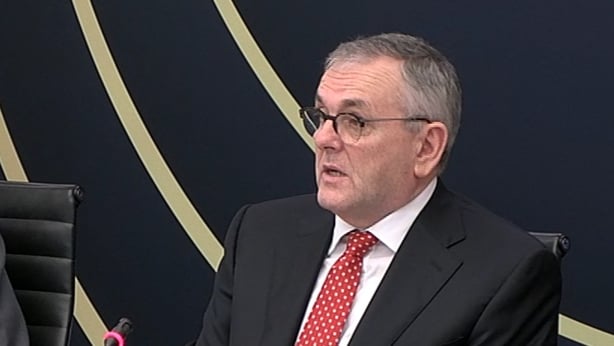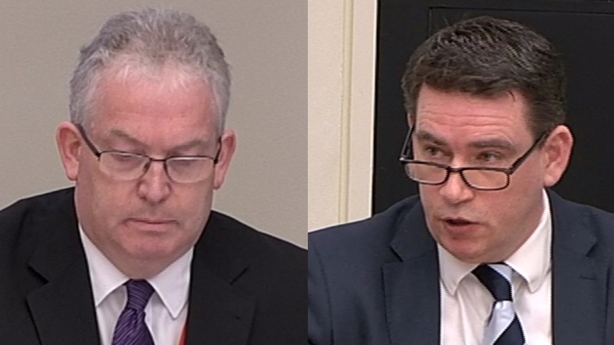A Commission of Inquiry under Marjorie Farrelly Senior Counsel will now inquire into the issues surrounding the care of 'Grace'.
And there are so many questions, even now after multiple and voluminous reports, writes RTÉ's Colm Ó Mongáin.
The outstanding questions around decisions to keep her in the home in which she was placed by the health board for 13 years after abuse allegations caused the health board to remove other residents.
Questions about decisions made on the level of information to share with her birth mother and day service carers about the allegations of that home and many, many more.
But before the Farrelly Commission sets out to answer those questions, the Public Accounts Committee’s members today decided that they will have an opportunity to ask some questions of their own.
The HSE is to provide written answers within seven days to questions it will receive from PAC members by tomorrow morning.
Perhaps appropriately, the forum in which initial questions were asked on foot of protected disclosures by a whistleblower will see another, and perhaps final attempt to have its questions answered about 'Grace', two years on from its first examination of the issue.
In March 2015, a protected disclosure by a whistleblower to the then-PAC chair John McGuinness resulted in the HSE appearing before it the following April.

At this point, the whistleblower had been seeking answers themselves for about six years.
While the disclosure ostensibly concerned the procurement of reports on the care of 'Grace' and others in the foster home, it was the first time some of the shocking allegations about the home were aired in public.
But along with the allegations, there were questions, which begot further questions and further HSE appearances and heated exchanges with committee members.
PAC members wanted answers, the HSE could not provide many of them due to garda objections to publishing the reports of inquiries into 'Grace’s' care.
Unlike media broadcasts, there is little limit on the duration of PAC interrogations.
There is also the possibility of being invited back again and again if any inconsistencies – perceived or otherwise – arise when transcripts are examined.
So what will the HSE have to do to finally close the circle on this process of appearance and re-appearance?
Only answers can do this and in answering questions in a case like this, the detail is important.
The HSE has seven days to provide answers to the questions from the PAC members.
What will they face?
At a guess, based on some of the more heated exchanges, here are two possible areas:
The 'three-person panel'
On 2 February 2016, HSE Director General Tony O'Brien appeared at the PAC.
In answer to a question by TD John Deasy about the current whereabouts of those who had made decisions around 'Grace's' care, Mr O'Brien told the committee that the key decision makers had retired.
He described how the report by management consultant Conal Devine into 'Grace’s' care outlined the crucial 1996 decision to leave 'Grace' in the home in the southeast (after the removal of other residents).
He said it was made by a "three-person panel".
Those three people, he assured the committee, were no longer in the public service.
Here is the relevant section of the PAC proceedings :
John Deasy: Who made the decision to leave 'Grace' in the foster home?
Tony O'Brien: That was made by a group of individuals in the South Eastern Health Board in the middle of the 1990s, but there were further opportunities later. They are people whose participation in the process is detailed in the Conal Devine report. I have been asked by An Garda Síochána not to publish the report, so I hope the committee understands that I cannot go into line by line detail as to what is in the report, because that would effectively be to publish it.
John Deasy: Let us stick with the individuals who made that decision. Before he leaves the committee room, he will have to address this and satisfy the members of the committee that the individuals involved and responsible for this will account for themselves. That is critical, necessary and obvious.
Tony O'Brien: In relation to the events of the 1990s, the individuals concerned are no longer in public service. In relation to subsequent events, the Conal Devine report was commissioned specifically to identify—
John Deasy: Is Mr O'Brien sure all of them are not in public service? Is he absolutely sure about that?
Tony O'Brien: The three who made the decision to which I referred —
John Deasy: That is not what Mr O'Brien said. I am not talking about that specific decision. I am talking about people in the HSE and the health boards who were involved in the foster home and decisions about the foster home. They are still in public service. Is this correct?

Tony O'Brien: Let me answer the question again.
John Deasy: No, answer that question. Is that correct?
Tony O'Brien: If I was unclear in my first answer, I need to restate it. I know the Deputy will allow me to do so. I referred in my first answer, when the Deputy asked me for what I was apologising, to a specific decision that was made to leave 'Grace' in the foster home in the 1990s.
This was made by a three-person panel, for want of a better word, and those three persons are no longer in the public service to be clear about that."
At the time of the exchange above, the report by management consultant Conal Devine into 'Grace’s' care was not in the public domain.
Last week it was published.
Of the decision to leave 'Grace' in the home at the centre of abuse allegations, Conal Devine said the following:
5.4.2 "The Inquiry team would be of the view that the decision taken at the October 1996 case conference to reverse the outcome of the April case conference was taken by the professionals concerned including H7, H6 & H4 ... The consequences were for 'Grace' to be in the home beyond her 18th birthday."
5.4.3 "The Inquiry team would be concerned that the actions and apparent omissions on the part of the professionals involved in 1996 were directly connected to 'Grace’s' continued placement with the 'foster parents'".
At the time of Mr O’Brien’s answer to the PAC, one of the three-person group referred to by Conal Devine was still working in the public service.
However, the HSE insists that the three-person group in the Conal Devine report is not the group to which Mr O’Brien was referring.
The HSE says that Mr O’Brien was referring to three professionals who made the decision both to keep 'Grace' in the home and those tasked with ensuring that the placement was made safe with appropriate monitoring.
So what are the questions:
- In what specific section in the Conal Devine report is the HSE’s three-person group defined as a three-person panel?
- Why is the follow-up element of responsibility (as opposed to the decision to keep 'Grace' in place) not mentioned in Tony O'Brien's answer to John Deasy?
- Given its omission, could committee members have been forgiven in February 2016 for now thinking that the three-person group referred to by Conal Devine is the one to which Mr O'Brien also referred, notwithstanding his later qualification of what he meant outside the PAC?
- On what did the HSE base its answers, if it was not the Devine report, given the difference between the HSE view and that of Conal Devine of who the three key professionals in 1996 were?
2. Contacts with gardaí and garda objections to publishing reports
The HSE accurately informed the Public Accounts Committee at its first appearance in April 2015 that gardaí investigating allegations relating to 'Grace' objected to the publication of Conal Devine’s report (as well as a follow-on report, which resulted from Mr Devine’s recommendations).
Documents released under Freedom of Information show that gardaí did object to publication between 6 March 2015 and 15 July 2016 (remember these dates).
The recent release of documents under FOI to RTÉ show all the contacts during this time.
But many PAC members took from the HSE answers that the garda objections to publication began in 2012 when Conal Devine completed his report.
It was a constant source of friction between HSE representatives and committee members - the HSE could not discuss reports gagged by gardaí and therefore members could not get the answers they wanted.
The most recent HSE statement in March 2017 and its answer to PAC in April 2015 may explain the PAC members' belief. Both accurately refer to constant contacts with gardai about Conal Devine.
However, a story broken by RTÉ’s This Week on Sunday shows that the first such contact specifically about publication of the report was not until 6 March 2015, the day after the HSE was contacted by the PAC on foot of a whistleblower's protected disclosure.
Conor Dignam SC, whose November 2016 300-plus page report recommended the establishment of the Farrelly Commission, also finds no direct evidence of an intention to publish the Conal Devine report before a letter written in April 2015.
He does, however, make reference to Mr Devine's own references to publication, and references to the matter within the HSE.

Garda objections to publication of reports were also offered by the HSE as the rationale for a delay in holding HR or disciplinary inquiries within the HSE.
Both Conal Devine and the Resilience Ireland team conducting follow-up reports managed to carry out their inquiries and to furnish relevant parties with sections of their reports for right of reply, a form of publication, albeit limited.
Some questions arising here are:
- What was the nature of the first contact between the HSE and gardaí on the subject of publishing the Conal Devine report?
- Why did the HSE feel bound by this, given Conor Dignam SC’s view that the HSE, while correct in considering the garda view, could have acted independently?
- Was this contact left to local area staff and local gardaí in 'Grace’s' area?
- Was local contact appropriate or advisable, given that Mr Devine’s report examined the role of both local staff and some local gardaí?
* The FOI documents on HSE-garda contacts about publication of the Devine report released to RTÉ shows that the last reference to garda objections to publication was dated 14/7/16.
The HSE Director of Social Care was advised by HSE lawyers that gardai in Grace’s local division still objected to the publication of the Devine report.
However, the FOI documents released to ‘This Week’ also show that twenty-four hours later, Assistant Commissioner Eugene Corcoran wrote to Conor Dignam SC, who was appointed by the Department of Health to conduct a review of Grace’s care in preparation for a commission of inquiry.
Asst Comm Corcoran informed Mr Dignam that the publication of the Devine report was solely a matter for the HSE and that gardaí had no objection to its publication, if the HSE deemed it in the public interest.
What explains the difference in the garda attitude at a local and at HQ level to the publication of the Conal Devine report on 14/7/2016 and the position as outlined by Mr Corcoran 24 hours later?*
This covers just two of the themes running through the HSE’s appearances at the PAC on 'Grace'. It could be another long meeting.
Colm Ó Mongain is the editor of and presents RTÉ's This Week on Radio 1, Sundays 1pm
* This article has been amended on foot of “unintended…genuine clerical errors” found by the HSE in the original documents released under FOI







